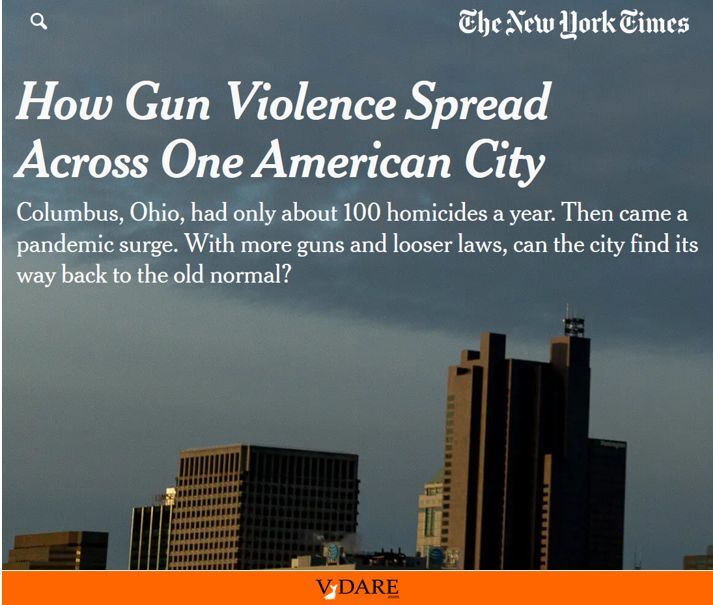
By Steve Sailer
05/21/2024
From The New York Times news section:
How Gun Violence Spread Across One American City
Columbus, Ohio, had only about 100 homicides a year. Then came a pandemic surge. With more guns and looser laws, can the city find its way back to the old normal?
By Shaila Dewan and Robert Gebeloff
Shaila Dewan reviewed police reports and court transcripts, and visited the scenes of a dozen fatal shootings in Columbus. Robert Gebeloff analyzed the geographic pattern of more than 120,000 gun homicides in America between 2016 and 2023.
May 20, 2024
The sequence of events that led to the killing of Jason Keys was so confounding that friends and family did not quite believe it until they saw the video evidence played in court.Mr. Keys and his wife, Charae Williams Keys, were getting into their car after a Father’s Day visit in 2021 with her grandparents in a leafy neighborhood near Walnut Hill Park in Columbus, Ohio. A 72-year-old neighbor carrying a rifle accosted them in the belief, he later told the police, that Mr. Keys had let the air out of his daughter’s tires and poisoned his lawn.
Mr. Keys, who was carrying a pistol in his waistband, and his father-in-law tried to disarm the man, knocking him to the ground, while another relative ran back inside to get a .22 rifle. While Ms. Keys ducked behind the car to call 911, she heard multiple gunshots. She emerged to find her husband mortally wounded.
It took a moment for everyone to realize that the shots had come from a fourth gun across the street. Elias Smith, a 24-year-old ex-Marine, had stepped to his front door with a so-called ghost gun, an AR-style rifle that Mr. Smith had assembled from parts ordered online. Within seconds, he opened fire, hitting Mr. Keys five times.
“What are you shooting for?” a relative of Mr. Keys can be heard asking on surveillance video that captured parts of the incident.
Mr. Smith answered, “I don’t know.”
OK, let me describe the cast of characters in racial terms, which the NYT refused to do, but would have emphasized if the races were reversed.
The victim, Jason Keys, is a white man with a black wife. The elderly neighbor who started the brouhaha is black. The young bystander who shot Keys for no obvious reason is also black. (By the way, the black participants look fairly mixed, so I’m guessing it’s a neighborhood favored by people in mixed marriages and the like.)
It was an encounter emblematic of gun violence in America today, a dispute that might not have turned deadly but for firearms in increasingly easy reach. And it was an episode that exemplified a striking spread in fatal shootings nationwide since the beginning of the pandemic in 2020 — a period in which Americans have purchased more guns, the Supreme Court has made them harder to regulate, and many states, including Ohio, have loosened restrictions on firearms.
The block, on the far east side of Columbus, had been a haven, with little if any gun violence. That kind of peace was what had drawn Ms. Keys’s grandparents to the area decades earlier, luring them from the center of the city to what promised to be a safer place to raise their family.
And then, nearly 30 years after they had settled into a ranch house on Walnut Hill Park Drive, a burst of gunfire would take the life of Mr. Keys and with it, the neighborhood’s sense of security.
A New York Times analysis of fatal shootings across the country found that as the toll of gun violence rose during the pandemic, the carnage expanded its boundaries as well.
Pandemic, pandemic, pandemic. Guns, guns, guns.
Who started shooting in much higher numbers after May 25, 2020?
Crickets, crickets, crickets.
In the NYT tradition, the article of course never mentions anything else that influenced crime in 2020, such as George Floyd, Black Lives Matter, or the racial reckoning.
But it’s easy to look up data from the CDC WONDER website on homicide deaths by race in Franklin County, Ohio, whose county seat is Columbus.
In 2019, 38 non-Hispanic whites died by homicide. In 2020, despite the all-powerful pandemic and the surge of gun purchases during the Mostly Peaceful Protests (which by the way appear to have helped prevent the enormous amount of retail looting that summer from spilling over into home invasions), 39 whites died by homicide.
In 2019, 71 blacks died by homicide, but in 2020, 143 blacks died by homicide.

So, the 2020 pandemic and heightened gun sales appeared to have little impact on whites in the Columbus area, but doubled the number of blacks getting murdered.
My guess is that the endlessly lauded Black Lives Matter movement had something to do with all those extra black lives murdered, but the NYT finds the abundant evidence for that not fit to print.
Hence, Democrats obsess over passing more point-of-sale gun control to keep law-abiding rural rednecks from buying rifles while simultaneously electing urban DAs who discourage cops from engaging in effective point-of-use gun control to discourage felons from carrying illegal handguns.
This is a content archive of VDARE.com, which Letitia James forced off of the Internet using lawfare.